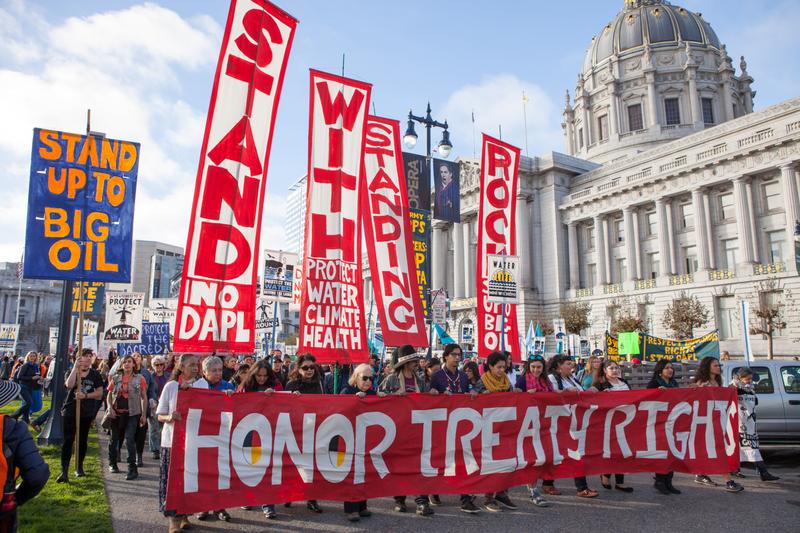What does it mean to defend the right to protest when powerful corporations weaponize the law to silence dissent? How do we confront a system that punishes advocacy while enabling environmental destruction?
This is an urgent conversation with Steven Donziger—human rights lawyer, environmental advocate, and a key observer of the shocking legal persecution of Greenpeace by the fossil fuel giant Energy Transfer. Donziger, who himself endured years of detention after Chevron targeted him for his work in Ecuador, exposes the brutal reality of SLAPP lawsuits—Strategic Lawsuits Against Public Participation—designed to crush activism through endless litigation, bankrupting organizations and intimidating dissent.
Tanya Singh: Could you briefly tell our readers about the Greenpeace trial in North Dakota?
Steven Donziger: This was an extraordinary case and, in my view, one of the most important cases in U.S. history. I was one of nine attorneys monitoring the trial for due process violations. Greenpeace was sued for hundreds of millions of dollars by a Texas-based pipeline company, called Energy Transfer, over the fallout from the historic Indigenous-led protests at Standing Rock in the U.S. state of North Dakota in 2016. The company claimed the protests delayed the opening of its Dakota Access Pipeline (DAPL), costing it hundreds of millions in lost revenue and increased costs for security, public relations, and financing. There was a big question as to whether these damages were real, but regardless, the theory of the company’s case was that Greenpeace was responsible for 100% of them. For context, the pipeline was constructed to carry oil from the tip of North Dakota, just south of Canada, for approximately 2,000 kilometres to Illinois, where it is offloaded onto barges and transported to the Gulf Coast for export to the world.
The irony is that Greenpeace played almost no role in the Standing Rock protests. The organisation had six people there in a support role, mostly to train people in non-violent civil disobedience, whereas 100,000 people had gathered at various times under the leadership of the Standing Rock Sioux. Greenpeace was targeted as a sort of sacrificial lamb for something much larger.
TS: What was really going on with the trial if Greenpeace had such a minor role?
SD: The lawsuit, in my view, is an attack on the entire climate movement, on Indigenous peoples, and on the First Amendment right to protest, which is sacrosanct under the U.S. Constitution. Greenpeace was the stand-in for all of that. Energy Transfer literally spent millions and millions of dollars on expensive corporate law firms to target Greenpeace over eight years, starting in 2017, as a way to carry out a vicious campaign to try to criminalize the organization and, by extension, the climate movement. The mastermind and financier of this attack is Energy Transfer’s Founder and Chairman, Kelcy Warren. Warren is a billionaire and a huge ally of the Trump Administration; the company’s employees gave around $12 million to Trump’s last campaign. Warren also seems to hate the very idea of protest. He once said in an interview that all activists “should be removed from the gene pool.” He’s arrogant, politically motivated, and has ample funds to wage legal warfare against those who challenge him. He said the purpose of the lawsuit is to “send a message” to the climate movement.
TS: What about the Indigenous peoples in the area? Were they involved in the trial?
SD: Central to this battle is the Standing Rock Sioux tribe, part of the great Indigenous nations of the United States. The pipeline crossed the ancestral lands of the tribe and they were not happy about it. In fact, they had not been properly consulted as required by law and they certainly did not grant permission.
The Great Sioux Nation, prior to the arrival of settler-colonizers, owned a massive amount of land that covered seven states, including what later became the states of North and South Dakota. The United States government essentially stole 95% of that land, violated treaties, forced the Sioux onto reservations, and abducted thousands of Sioux children into brutal boarding schools where many died. The battle over the pipeline cannot be understood without understanding its historical context.
The specific problem here is that the DAPL had been re-routed in 2014 to cross ancestral Sioux lands from its original route north of the state capitol of Bismarck, about 90 kilometres away. That northern route had met significant opposition from the colonizer-elites in the state who were worried about potential environmental problems, particularly as the pipeline crossed under the Missouri River. So the pipeline was shifted south, threatening Indigenous ancestral lands, largely because the Indigenous peoples were considered politically weak. The new route of the pipeline, and the utter disrespect it showed for the Standing Rock Sioux, combined with these legitimate historical grievances, is what prompted the protests to begin in the summer of 2016.
The goal was to block the pipeline from crossing Sioux territory, where it posed a major threat to drinking water sources and other sacred cultural sites, including burial grounds. The protests led by the tribe eventually attracted representatives from 300 Indigenous tribes in North America, as well as war veterans, church groups, and activists. This degree of opposition infuriated Kelcy Warren, who fought back by hiring private security guards who, at times, attacked peaceful protestors with dogs and tear gas, infiltrating the protest movement. Warren later wanted to attack further by filing lawsuits. That eventually led to the trial we just witnessed.
I’ll add that the protests ended, and the pipeline became operational in 2017, even though it lacked proper permits. It’s still operating today without proper permits, and litigation between the tribe and the U.S. government over whether it can be shut down continues. An expert report submitted in the Greenpeace trial found that the pipeline had leaked significant amounts of toxic drilling fluids into drinking water sources.
TS: How did the trial hit you personally given that you had faced a major legal attack by Chevron, resulting in your detention from 2019 to 2022?
SD: What’s interesting to me personally is that the trial was an attempt to criminalize Greenpeace for engaging in peaceful protest. The same law firm (Gibson Dunn) that Chevron used against me in 2011, for my work supporting Ecuadorian Amazon communities in their $10 billion pollution lawsuit, was used by Energy Transfer to retaliate. The law firm tried to criminalize me for my human rights legal work in Ecuador. They are trying to criminalize Greenpeace for its advocacy to help our country transition out of fossil fuels, a stance that obviously threatens the business model of Energy Transfer.
Both of these cases are, in my opinion, unconstitutional attacks on advocacy, but pro-corporate judges let them proceed. They are certainly part of the same through-line and are central to a new corporate playbook to weaken advocacy for the environment and Indigenous rights.
TS: Talking about the way Energy Transfer misused the law, Greenpeace had appealed to the North Dakota Supreme Court for a change of venue, Morton County, which was denied. What does this say about judicial fairness and the ability of advocacy groups to secure impartial trials in a case like this?
SD: Energy Transfer deliberately chose Morton County, which has only 33,000 people, because they knew Greenpeace could not get a fair trial there. Almost 80% of county residents voted for Donald Trump and the county is heavily dependent on fossil fuels. A pre-trial survey of county residents found that 97% said they could not fairly judge Greenpeace if they were seated as jurors. Yet the judge denied several motions by Greenpeace to move the trial to a different venue.
In my opinion, Greenpeace stood no chance because of the bias of the jury pool. The jury that ended up seated included no Native Americans or people of colour. The pre-existing bias of the jury was also inflamed further by a very public but highly inappropriate advertising campaign by Energy Transfer in the county in the lead-up to the trial. The company ran ads on television, and online, and sent a fake “independent” newspaper to residents that trashed the protestors. The judge never stopped it, despite repeated requests from the Greenpeace legal team.
It's a sad commentary on the US judicial system that this case even went forward. In my opinion, given that the case was an attack on the First Amendment, it should have been dismissed right at the beginning.
Since this jury was not impartial, the case was not a trial — at least not in the way the word trial is commonly understood. The case was what I would call a choreographed show by lawyers presented to a jury that was completely predisposed to agree with everything that was being said. When the other side, Greenpeace, tried to put on his evidence, the judge was consistently making rulings from the bench, denying Greenpeace the ability to use its evidence. So Greenpeace’s ability to defend itself was gutted by the rulings of a judge who, to me, was biased too.
People must not assume Greenpeace did anything wrong because they lost the trial. They were targeted with a fake trial because of the good work they've been doing to protect the environment over the last several decades, and for the broader reasons I mentioned previously.
TS: You've also mentioned that this lawsuit could set a precedent to stifle free speech and peaceful protest. Could you elaborate on that?
SD: It is unquestionable that in the last several years there's been a deep intensification of attacks on the right to protest, not just here but all over the world. And in terms of the environmental movement, there are not just attacks on the right to protest, there are systematic campaigns of disappearances and assassinations of environmental leaders.
Global Witness documented approximately 1500 such assassinations, mostly in Latin America, over the last 10 years. People who speak out against corporate abuse, environmental abuse, against the abuse of indigenous peoples are often subject to extrajudicial executions in the Global South. I would argue, that in the north, like the United States and Europe, this attack strategy manifests partly as weaponised lawsuits designed to intimidate people and scare them into giving up their free speech rights. People generally don’t get killed; they get bankrupted, or at least that’s the idea. These are what I call ritual killings through silencing and intimidation. The body survives, but the advocacy is killed off.
The way it works is that the more powerful entity, in this case, a pipeline company with billions of dollars, hires a law firm that acts as a sort of goon squad with suits and ties. They file a lawsuit against the target and accompany it with a public relations defamation campaign. Such lawsuits are designed to impose a backbreaking burden on the target. Just to defend them costs massive sums of money and time, not to mention the risk of reputational damage. So they either have to give up their speech and stop their campaign to end the lawsuit, or they fight the lawsuit and in so doing divert the vast majority of their financial resources that otherwise would have been used to fight for a more sustainable planet or for whatever their social justice goals are. It’s an impossible choice, which is why these illegitimate lawsuits just by being filed can be so effective for the fossil fuel industry.
In the United States and Europe, there’s a term for it. It’s called a SLAPP Lawsuit, which stands for Strategic Lawsuit Against Public Participation. It is a lawsuit filed not to resolve meritorious legal claims, but to harass the other side. That's what the Green Peace case is. And these SLAPP lawsuits have become a favourite of the fossil fuel industry all over the world, but definitely in the United States. But just to be clear, SLAPP lawsuits can be filed by governments as well. For example, we recently saw the arrests and possible deportations of university students in the United States by the Trump Administration in retaliation for speaking out against the abuses by the Israeli government in Gaza and beyond. Those also are lawsuits designed to silence legally protected free speech rights.
There's a certain technique to these lawsuits. There's even what I would call a “dark art” to do them successfully. The most effective ones violate the Constitution but are designed artfully to look like real trials – the claims are real, such as defamation claims. There are lawyers for both sides. By they hide the true nature of the lawsuit, which is to use asymmetries of power to crush the activists. That was on full display in North Dakota during the Greenpeace trial, which is why the result is illegitimate. And I believe ultimately Greenpeace will prevail on appeal. But Greenpeace has now been through literally eight years of litigation fighting this pipeline company. Even if they win, one could argue the cost has been so high they got crushed, anyway.
The pipeline company, I guarantee you, has spent several hundred million dollars on legal fees. The lawyers who do these, these dark artists of SLAPP suits at the Gibson Dunn law firm, charge upwards of $2,000 per hour for their services.
TS: While I am sure Energy Transfer can afford that much money, I'm thinking about what would be the scenario if the party being sued was a student-led organization. It is impossible to deal with the monetary implications of such lawsuits.
SD: Well, if you're just a person dealing with this, it's very difficult to withstand it. People often end up in prison, bankrupt, or silenced. I got through it because I had a huge amount of solidarity from the world, from lawyers who worked for me pro bono to dozens of Nobel Laureates and legal organizations. But it was still quite the ordeal because it led to almost three years of detention and it still haunts me, given that because of Chevron I still cannot travel out of the country or practice law.
TS: In light of Energy Transfer succeeding in this lawsuit, do you think indigenous-led movements or other targets of SLAPP lawsuits have any safeguards in law that could be implemented to prevent the misuse of such lawsuits?
SD: These SLAPP harassment cases, regardless of who is targeted, have to be fought from the outset with a clear-minded understanding of what they are and with an appropriate strategy that connects the inside of the courtroom with public advocacy on the outside. The most important thing is to call out the illegitimacy of the SLAPP lawsuit from the outset and to do it loudly, consistently, and publicly not just in legal motions but in press releases and outreach to the media. Building solidarity in the community is critical. Finding the right lawyer who understands what is happening and can file the appropriate motions to dismiss these cases before they enter the discovery phase, where they become really burdensome, is also critical. Those targeted also need a lawyer with personal courage who is not afraid of taking on the judge and the law firm on the other side, and who is willing to call them out for using the judicial branch to violate the law. The worst thing to do — and I've seen many lawyers fall into this trap — is to respond to these attacks like they are normal lawsuits where the battle takes place only within the four walls of the courtroom. Suddenly you find yourself taking depositions and responding to subpoenas, which can be both expensive and distressing. Worse, lawyers who litigate SLAPPs like they are regular lawsuits often end up accelerating the demise of their own client, because their approach legitimates the lawsuit as "normal" when in fact it violates the Constitution and is often rigged so it's impossible to win.
The problem there is when you lose a rigged trial without calling it out loudly and consistently, it can appear like you did something wrong. Greenpeace did a great job calling out Energy Transfer's fiendish strategy every step of the way, so that when it lost, people understood it was because it did not get a fair trial. So finding a lawyer who can mount an appropriate strategy taking all of this into account is an absolute imperative. Obviously, that takes a certain level of resources that many people don't have. But the resources needed to try to get the case dismissed at the outset are not substantial. In addition, non-profits like the ACLU [The American Civil Liberties Union] and the coalition Protect the Protest are sometimes willing to litigate these cases pro bono.
In the meantime, there is some hope. Roughly 30 US states have anti-SLAPP laws, which provide procedural mechanisms to get these cases dismissed more easily and to fine the perpetrator for the legal costs. They are not strong enough, but they are a good start. Even in states without such laws, these cases can be dismissed based on constitutional claims. The EU also has passed a new anti-SLAPP directive, which Greenpeace is using to sue the pipeline company in Amsterdam, in Dutch courts, in order to recoup their costs from the case. This is a huge and important development that could flip the tables of this entire battle. In the US, a new federal anti-SLAPP law has been introduced in both houses in Congress. While it likely won't pass in the current environment, it is the basis to make some real progress on a national level. All of these laws reflect an increasing recognition that these illegitimate lawsuits, both from corporations and governmental entities, violate free speech rights and need to be stopped. We need to spread the word about what SLAPP lawsuits are, and speak out to defend groups like Greenpeace and individuals like myself who have been targeted.



